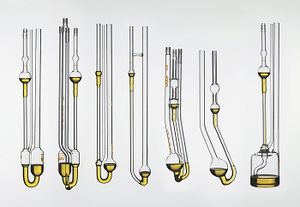Difference between revisions of "Viscometers"
(Created page with "Category:Meters, Gauges{{Knoppen}} <noinclude><!------------------------------------------------ * READ THIS FIRST * Only edit this page if you can improve the content. ...") |
|||
| Line 7: | Line 7: | ||
* Please start editing this page after the /noinclude | * Please start editing this page after the /noinclude | ||
* -------------------------------------------------></noinclude> | * -------------------------------------------------></noinclude> | ||
[[File:Viscometer.jpg|thumb|right|Viscometers]] | |||
'''Viscometer''' also called viscosimeter is an instrument used to measure the viscosity of a fluid. For liquids with viscosities which vary with flow conditions, an instrument called a rheometer is used. Viscometers only measure under one flow condition. | |||
In general, either the fluid remains stationary and an object moves through it, or the object is stationary and the fluid moves past it. The drag caused by relative motion of the fluid and a surface is a measure of the viscosity. The flow conditions must have a sufficiently small value of Reynolds number for there to be laminar flow. | |||
In one type, the time taken for a given volume of fluid to flow through an opening is recorded. In the capillary-tube viscometer, the pressure needed to force the fluid to flow at a specified rate through a narrow tube is measured. Other types depend on measurements of the time taken for a sphere to fall through the fluid, or of the force needed to rotate the inner cylinder of a pair , or of the rate at which oscillations of a disk vibrating in the fluid die out. | |||
Revision as of 10:53, 25 December 2012
Viscometer also called viscosimeter is an instrument used to measure the viscosity of a fluid. For liquids with viscosities which vary with flow conditions, an instrument called a rheometer is used. Viscometers only measure under one flow condition. In general, either the fluid remains stationary and an object moves through it, or the object is stationary and the fluid moves past it. The drag caused by relative motion of the fluid and a surface is a measure of the viscosity. The flow conditions must have a sufficiently small value of Reynolds number for there to be laminar flow.
In one type, the time taken for a given volume of fluid to flow through an opening is recorded. In the capillary-tube viscometer, the pressure needed to force the fluid to flow at a specified rate through a narrow tube is measured. Other types depend on measurements of the time taken for a sphere to fall through the fluid, or of the force needed to rotate the inner cylinder of a pair , or of the rate at which oscillations of a disk vibrating in the fluid die out.
